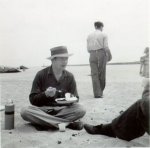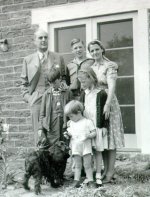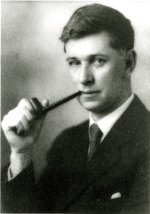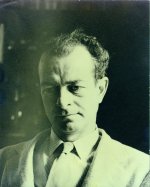
The War Years, Part 1 (1940-1942)
1940
Dan Campbell arrives in Pasadena as a Rockefeller Fellow (his fellowship begins on January 1). Although he comes to do crystal structure studies on hemoglobin, he ends up in serological work and eventually obtains a permanent position in immunochemistry. He and Pauling will collaborate on several papers.
Pauling publishes a paper in JACS, which will become his ninth most cited, on the theory of the structure and the process of formation of antibodies. His view, later called the instructive theory of antibody formation, postulates that the antigen acts as a template that directs the folding of the nascent antibody chain. In his model, antibody molecules of a given amino-acid sequence have the potential for forming combining sites of many different specificities. The particular one formed depends on the antigen present at the time of folding. A consequence of Pauling’s theory is that a specific antibody cannot be formed in the absence of the corresponding antigen, but this prediction differs from experimental results that are obtained in various laboratories.
Beginning in the summer, during the Battle of Britain, CIT devotes an increasingly large part of its personnel and facilities to the furthering of national defense and the war effort.
On July 23, Pauling delivers his first important lecture on something other than science: He speaks to the local chapter of the Federal Unionist Club in Pasadena on Union Now (this organization, in which both Linus and Ava Helen Pauling are active, is devoted to bringing British children to America to escape the threatened invasion of Great Britain). Pauling tells his audience that the war going on is one between democracy and autocracy, that the United States is in a precarious position, and that if England is defeated, the United States will become an economic slave of Germany. Pauling wants to stop Hitler quickly, before he does more harm.
On July 26, Pauling and Max Delbrück publish a paper in Science on the nature of the intermolecular forces operative in biological processes. Their paper is a response to the German physicist Pascual Jordan’s advocacy of the idea that, because of quantum mechanical resonance, identical molecules attract one another more strongly than nonidentical molecules. Pauling believes, because of his work on antibodies, that biological specificity results from the detailed molecular complementariness of the interacting groups. Furthermore, the extra energy from quantum mechanical resonance is less than the energy of thermal agitation. In the opinion of Pauling and Delbrück, the processes of synthesis and folding of complex molecules in living cells involve such intermolecular interactions as hydrogen-bond formation which provide stability to a system of two molecules with complementary structures in juxtaposition (rather than Jordan’s two molecules with identical structures).
In the fall, Pauling signs an open letter to Congress that states that he and the other signers believe that "the Axis powers—Germany, Italy and Japan—have clearly demonstrated that it is their purpose not merely to defeat their present enemies, but to conquer and dominate the world and to impose upon the peoples of the world a form of physical, mental, and spiritual slavery designed solely to perpetuate the domination of the Axis Powers."
Pauling believes that the Axis Powers can and will be defeated if the American people do their part. He begins to do his part by becoming involved in various types of war work in explosives, rocket propellants, and medical research.
At the invitation of Pauling, Laszlo Zechmeister comes to CIT. He is widely known for his research in chromatography and spectroscopy.
The second edition of The Nature of the Chemical Bond is published.
On October 3, Pauling attends a meeting in Washington in which mention is made of the need for an instrument that can measure the partial pressure of oxygen in a gas. In only three days, Pauling is able to devise the basic idea for a simple and effective instrument fulfilling this purpose based on the magnetic susceptibility of molecular oxygen. At CIT, he and his collaborators build this oxygen detector, whose main component is a small glass dumbbell with hollow spheres to which a mirror is attached which is suspended on a quartz fiber in an inhomogenous magnetic field. Hundreds of these instruments will be built for use in submarines and airplanes.
In October, Pauling has a severe sore throat and feels very ill. A month later, he notices that his neck is so swollen that he cannot button his collars.
During the November elections, the CIT students organize a debate on the Democratic and Republican candidates. Pauling ably defends the positions of President Roosevelt against Wendell L. Wilkie.
1941
Early in March, Pauling gives a lecture in Boston, and he notices that his face is swollen. He then goes to New York City where, on March 7, he receives the William H. Nichols Medal of the New York Section of the American Chemical Society for his fundamental contributions to the nature of the chemical bond. Friends and colleagues notice that his face is "all puffed out with his edema." After the ceremonies, Linus and Ava Helen are at the apartment of Alfred Mirsky, and Dr. Alfred Cohn, a professor at the Rockefeller Institute for Medical Research, learns of Pauling’s condition and asks to examine him. The next morning, Cohn and some other doctors, after performing various tests, diagnose glomerulonephritis, a renal disease characterized by the abrupt onset of facial edema and hypertension. They ask Pauling what he plans to do. Pauling replies that he intends to go to the Mayo Clinic where he is scheduled to give a memorial address. One of the doctors advises Pauling to cancel the speech and return to California, where he should get in touch with Dr. Thomas Addis in San Francisco, a specialist in the treatment of nephritis.
On March 10, Linus and Ava Helen return to Pasadena. He arranges to see Addis, and, within a short time, Addis begins treating him. (He later tells Pauling that it was extremely fortunate that he did not go to the Mayo Clinic, because the doctors there would have pumped him full of a natural polysaccharide, and his edema would have disappeared, but he would have been dead in a little while.) Pauling is put on a low-protein diet and takes various vitamins and liver extracts.
J.T. Edsall, who is at CIT as a Guggenheim Fellow, prepares synthetic polypeptides of known amino-acid composition to help solve the problem of protein structure.
During the summer, Pauling works on elastic explosives and rocket propellants.
In August, Pauling’s edema finally goes away.
Pauling oversees experimental work on serological reactions with simple substances containing two or more haptenic groups. This work leads to a series of papers in which much useful information is presented on the nature of the interaction of antibodies formed by reaction with antigens having haptenic groups of known chemical structure.
On December 7, the Japanese attack Pearl Harbor, and Ava Helen Pauling, feeling the seriousness of the situation and believing that the United States will now declare war, gathers her family together with the sense of trying to protect them from what is going to happen.
1942
In March, General John L. DeWitt, head of the Western Defense Command, issues the orders to gather 110,000 Japanese-Americans in California and three other states and to move them to hastily constructed "relocation centers." Ava Helen Pauling speaks out against sending Japanese-Americans to these camps.
Pauling, Dan Campbell, and David Pressman announce in March that, for the first time in medical history, antibodies have been formed artificially in laboratory flasks. Hitherto these disease-fighting substances have been formed only within the bodies of living persons and animals. This announcement of artificially-made antibodies makes the major newspapers and news magazines. They later publish a paper, "The Manufacture of Antibodies in vitro," in the Journal of Experimental Medicine. This paper creates interest and controversy. Landsteiner repeats the experiment and gets negative results. Others try and cannot reproduce the results of the experiment. Thus, the contention of Pauling, Campbell, and Pressman that they got serum globulin molecules to unfold by various means in the presence of antigens and then to fold up again, just as they would in the blood stream, is met with increasing skepticism. Nevertheless, Pauling continues to feel that what they found is real and should be able to be duplicated.
In the spring, Pauling works on propellants for high-altitude rockets. His research centers on nitrocellulose propellants, and his main concern is proper burning of these propellants.
In Pauling’s series of papers on the serological properties of simple substances, David Pressman becomes his most important collaborator. Pauling and Pressman occasionally use graduate and even undergraduate students to assist in the experiments on the precipitation reactions between antibodies and substances containing haptenic groups. For example, Carol Ikeda and Miyoshi Ikawa are two undergraduates of Japanese descent who participate in the first two papers in the series. Their work is mainly the preparation of the compounds that are used. Because of the war, Pauling experiences some difficulties in getting these students placed in graduate programs, but he eventually succeeds.
Pauling writes a paper on the composition of precipitates of antibodies and polyhaptenic simple substances in which he discusses the valence of antibodies. This is the third paper in the series on the serological properties of simple substances and, like its predecessors, it appears in JACS.
On August 10, James Bryant Conant, chairman of the National Defense Research Committee (NDRC) and deputy director of the Office of Scientific Research and Development (OSRD), phones Pauling, asking him to serve as chairman of an ad hoc committee on internal ballistics and special propellants. Pauling accepts, and all the work requested is, in due course, done.
In the fall, J. Robert Oppenheimer offers Pauling the job of Director of Chemistry and Metallurgy Division at Los Alamos (the atomic bomb project). Because of his nephritis and because he is heavily involved with several war projects, he refuses (Joseph W. Kennedy accepts the position on November 6). Oppenheimer, to entice Pauling to come, says that he will have liters of tritium with which to work, but Pauling sticks by his decision.
Pauling’s work as a member of the explosives division of the NDRC and as a participant on the consultative committee on medical research of the OSRD takes up more and more of his time.
Table of Contents
- The Ancestry of Linus Pauling (The Paulings)
- The Ancestry of Linus Pauling (The Darlings)
- Linus Pauling's Childhood (1901-1910)
- Linus Pauling's Adolescence (1910-1917)
- Pauling's Years as an Undergraduate at Oregon Agricultural College, Part 1 (1917-1919)
- Pauling's Years as an Undergraduate at Oregon Agricultural College, Part 2 (1919-1922)
- Linus Pauling as a Graduate and Postdoctoral Student at the California Institute of Technology, Part 1 (1922-1923)
- Linus Pauling as a Graduate and Postdoctoral Student at the California Institute of Technology, Part 2 (1924-1926)
- A Guggenheim Fellow in Europe during the Golden Years of Physics (1926-1927)
- Early Career at the California Institute of Technology (1927-1930)
- Pauling's Great Years of Achievement in Structural Chemistry, Part 1 (1931-1932)
- Pauling's Great Years of Achievement in Structural Chemistry, Part 2 (1933-1935)
- Pauling's Increasing Involvement in Molecular Biology (1936-1939)
- The War Years, Part 1 (1940-1942)
- The War Years, Part 2 (1943-1945)
- The Postwar Years, Part 1 (1946-1947)
- The Postwar Years, Part 2 (1948-1949)
- Proteins, Passports, and the Prize (1950-1954)
- Increasing Involvement in World Peace, Part 1 (1955-1958)
- Increasing Involvement in World Peace, Part 2 (1959-1963)
- The Center for the Study of Democratic Institutions (1964-1967)
- The University of California, San Diego (1968-1969)
- Stanford University (1969-1972)
- An Institute for Science and Orthomolecular Medicine, Part 1 (1973-1977)
- An Institute for Science and Orthomolecular Medicine, Part 2 (1978-1981)
- The Years Alone: Pauling after the Death of Ava Helen, Part 1 (1982-1988)
- The Years Alone: Pauling after the Death of Ava Helen, Part 2 (1989-1994)
- About the Author





